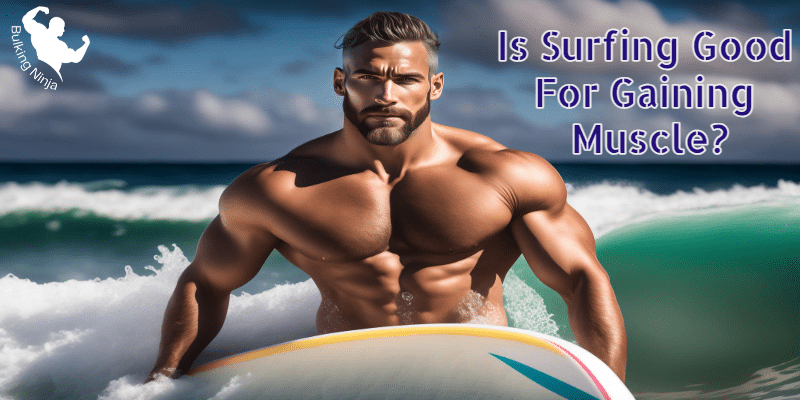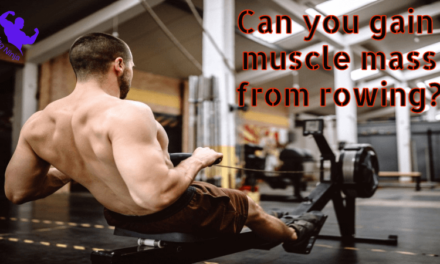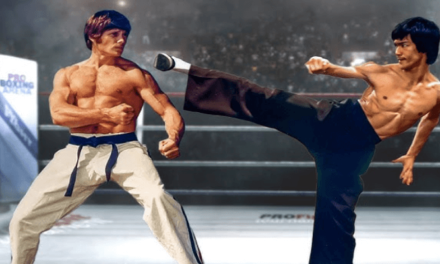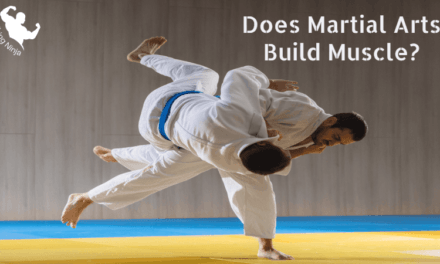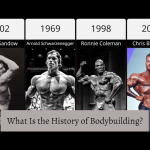Embracing the waves and riding the tides isn’t just about mastering a board and feeling the rush of the ocean; it could also be a path to building a stronger physique. The intriguing question that often surfaces is: “Is surfing good for gaining muscle?” Beyond the sun-soaked beaches and breathtaking swells lies a potential avenue for enhancing not only your surfing skills but also your muscular development.
In this exploration, we delve into the dynamic world of surfing to uncover whether it holds the power to sculpt muscles, bolster strength, and contribute to a more robust physical presence. So, grab your board and dive into the waves of knowledge as we ride the currents of this fascinating inquiry.
Table of Contents
Is Surfing Good For Gaining Muscle?
Surfers are renowned for their remarkable fitness levels, and it’s no coincidence that the art of surfing presents an all-encompassing workout. Engaging in this dynamic water sport goes beyond the surface, delving into the intricacies of muscle development and endurance building.
The journey begins with the fundamental act of paddling out, which in itself serves as an invigorating cardio workout, akin to the benefits reaped from swimming. The fusion of pushing and pulling against the water creates a higher resistance level than air, leading to an enhanced capacity for muscle endurance.
This unique combination stimulates muscle growth and fortitude in ways that traditional workouts may not. As surfers navigate the waves, they not only paddle against the water’s resistance but also harness the force of the waves themselves.
Swimming and paddling, propelled by the force of the waves, represent just the beginning of surfing’s muscular advantages. The act of “sprint paddling” into waves engages not only cardiovascular strength but also cultivates chest muscles, as surfers deftly navigate their way onto the crest of the wave.
As they “pop-up” onto the board, chest muscles are further activated, contributing to the overall development of upper body strength. Meanwhile, the core muscles are ignited as surfers ride and execute turns within the waves, maintaining balance and control through the undulating currents.
Surfing’s allure extends beyond its visual splendor, offering a holistic approach to fitness that integrates cardiovascular stamina, muscle growth, and core strength.
The interplay between paddling, pushing against water resistance, and maneuvering within the waves generates a symphony of muscle engagement, ensuring a comprehensive workout that targets various muscle groups.
Whether you’re a seasoned surfer or someone intrigued by the prospect of riding the waves, the undeniable benefits of surfing on muscle development make it an enticing avenue for those seeking both physical prowess and the thrill of the ocean’s embrace.
Which Parts of Surfing Build Which Muscles?
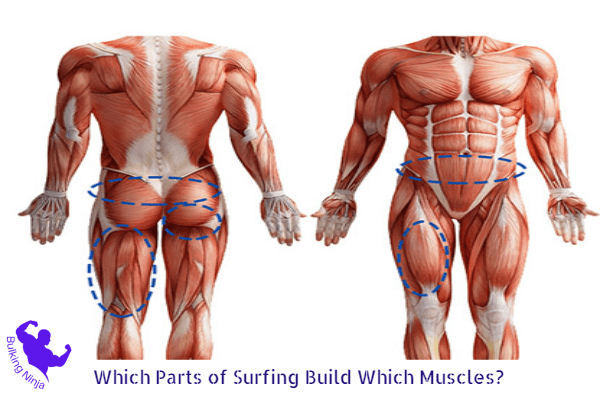
Paddling Out: The Foundation of Muscular Endurance
The rhythmic motion of paddling out is far more than a simple journey across the waves; it lays the foundation for a profound cardio workout. As a surfer propels forward, each stroke becomes an engagement of the core, shoulders, and arms, fueling endurance and cardiovascular strength. The very act that initiates a surfing session ignites the body’s energy reserves, setting the stage for a remarkable physical endeavor. Futher more study Important Types Best Sports for Grow Muscle.
The Sprint into Adrenaline: Harnessing Energy for Wave Catching
Transitioning from the cardio-driven paddle, surfers plunge into an exhilarating sprint. Paddling into a wave demands an explosive burst of energy, akin to an all-out sprint. This surge of effort not only propels them onto the wave’s crest but also releases a rush of adrenaline, amplifying their focus and enhancing the mind-muscle connection.
The Pop-Up’s Muscle Activation: A Push-Up into Strength
Once atop the wave, the “pop-up” maneuver becomes a showcase of strength. Comparable to a swift push-up, this motion involves engaging the chest, shoulders, and core muscles to swiftly elevate the body onto the board. This instantaneous activation contributes to upper body muscle building, exemplifying the multifaceted nature of surfing’s impact.
Dynamic Balance and Core Engagement: Riding the Wave’s Strength
Surfing’s interaction with the wave is a dance of precise adjustments, a testament to the body’s innate ability to adapt and excel. The subtle shifts in weight, the artful maneuvering, and the dynamic changes in motion engage the core muscles extensively. This core activation, akin to the effects of yoga, refines balance and builds a robust core foundation.
Endurance Meets Precision: The Fusion of Yoga and Dynamic Movement
The essence of surfing encapsulates endurance, analogous to the endurance cultivated in yoga. The journey from paddling through exhilarating sprints to dynamic adjustments while riding the wave mirrors the art of burpees, instilling strength through a range of motion. This fusion of varied movements elevates the concept of muscular endurance, creating a holistic impact on the body’s physical prowess.
As surfers embark on this aquatic adventure, the synergy of cardio workout, burst of energy, muscle engagement, and dynamic balance intertwines to sculpt a body that’s not just strong, but adaptive and resilient. Surfing’s potential as a means of gaining muscle becomes apparent through its seamless blend of cardio, strength, and precision. Read more about Wall Pushups good for gain Muscles.
How Does Surfing Build Muscle?
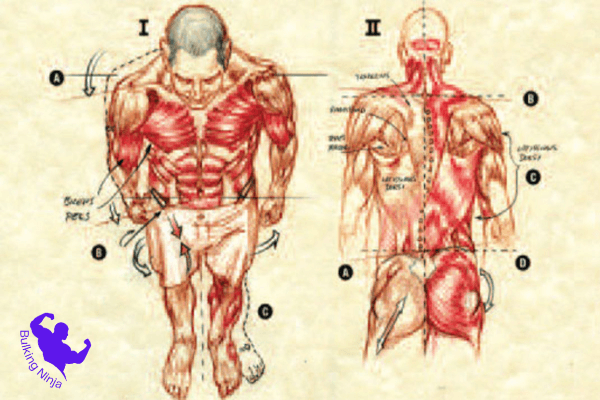
Paddling in the ocean isn’t just a means of navigation; it’s a full-body workout. It builds muscles in the back, lats, shoulders, arms, and chest, akin to using resistance bands in the gym. This repetitive motion in the water engages multiple muscle groups, making it an effective resistance training exercise.
Surfing isn’t just about riding waves; it’s an art form that engages muscles uniquely. The intentional arching of the back while riding the waves develops muscles in the lower back and neck, areas often neglected in traditional workouts. Surfing becomes a canvas for muscle development. read more about Lunges exercise grow muscles.
Standing up on a wave mimics a push-up, engaging muscles to transition from prone to upright. This movement, combined with maintaining balance on the wave, builds strength and stability. Skilled surfers further activate their core and thighs by constantly adjusting their limbs while riding the wave.
Surfing is a symphony of muscle engagement. Whether you’re a beginner or a seasoned surfer, every session contributes to improved muscle strength and endurance. Each wave ridden becomes an opportunity to enhance overall physical prowess. Surfing isn’t just an adventure; it’s a journey towards a stronger, more agile you. Futher more study important Types of Push ups for Grow Muscle.
Which Muscles Does Surfing Specifically Engage?
Paddling Out: A Symphony of Muscle Engagement
As surfers paddle out in pursuit of the perfect wave, an intricate symphony of muscles springs into action. The arms take the lead, with the triceps, biceps, and deltoids working harmoniously to navigate the waves.
The trapezius, rectus abdominis, latissimus dorsi, and obliques contribute their strength, forming a coalition of muscles that drive the surfer forward. The very act of paddling becomes a testament to the versatility of muscle engagement that surfing encapsulates. Let’s Start Your Bulking Journey with Best Easy High Protein Breakfasts for Muscle Building.
Riding the Wave: A Dance of Upper Body Strength
When the moment comes to pop-up on a wave, a sequence of muscles orchestrates the surfer’s rise. The pectoralis major, deltoids, triceps, and biceps collaborate to lift the upper body, setting the stage for the legs to step into action. The seamless coordination of these muscle groups transforms every wave into an opportunity to enhance upper body strength.
Feet to the Board: A Lower-Body Symphony
As the feet touch the surfboard, a shift occurs in the muscular landscape. The lower body takes center stage, featuring the quadriceps, gluteals, and the gastrocnemius. These key players power the surfer’s maneuvers, from bottom-turns to aerials.
Notably, the muscles of the hips take on a crucial role, propelling actions like carves and cutbacks. Each wave becomes a canvas for the lower body’s strength and agility.
In the realm of surfing, muscles become the artists, sculpting every movement and propelling every ride. From paddling out to riding the wave, a collective effort of triceps, biceps, deltoids, and an ensemble of other muscles creates a tapestry of strength and grace. With each session on the board, surfers not only conquer waves but also nurture a body that’s fortified by the waves themselves.
What Makes Surfing More Fun Than Other Types of Exercising?
The journey of surfing goes beyond the mere physical exertion; it intertwines passion and physical health in a profound manner. The impactful benefit lies in the connection forged with the sport. For surfers, it’s more than an activity; it’s a lifestyle. This connection, fueled by passion, has the power to elevate overall physical health beyond what a routine gym workout can achieve.
Surfing isn’t just a sport; it’s an embodiment of enthusiasm and love. The very essence of riding the waves transforms training from work to play. The joyous aspect of surfing redirects the notion of “exercise” into an exciting adventure.
The words of professional surfer Yadin Nicol resonate: training isn’t merely about abs or arms; it’s about becoming capable of pursuing what you love. This transformative shift instills a deeper sense of motivation.
The sense of community among fellow surfers adds another layer of joy to the surfing experience. It’s not just a solo pursuit; it’s a collective lifestyle. This camaraderie fosters an environment where the pursuit of becoming a better surfer is inherently joyful. Surfing is a journey that strengthens not only the body but also the bonds within the surfing community.
Scientific insight further underscores the exhilaration of surfing. A study published in Marketing Letters illuminates how viewing an activity as fun rather than exercise can fundamentally alter our perception. This redirection of attention from effort to enjoyment makes the workout feel more effortless. Surfing, as a source of pure enjoyment, aligns with this paradigm, creating a workout that doesn’t just sculpt muscles but also uplifts the spirit.
In the realm of surfing, muscles aren’t the only beneficiaries. The connection, passion, community, and joy it fosters, combined with the scientific revelations on enjoyment, make surfing an extraordinary avenue for gaining muscle while nurturing the soul.
What Are Health Benefits of Surfing?
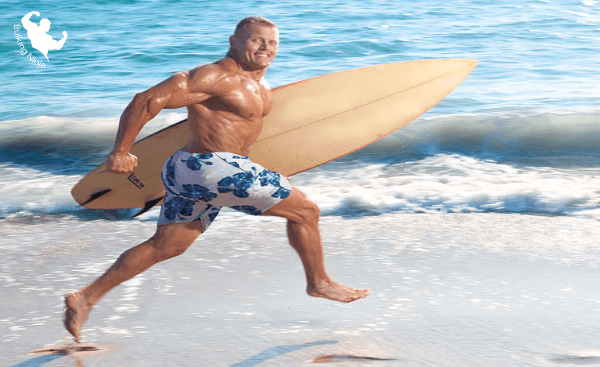
Beyond its muscle-building potential, surfing offers a myriad of health benefits that contribute to a holistic well-being:
Cardiovascular Fitness
Paddling through the waves and riding them requires continuous effort, leading to improved cardiovascular endurance and heart health.
Balance and Coordination
Maintaining stability on a constantly shifting surface sharpens your balance and coordination skills, enhancing overall body control.
Stress Relief
The soothing sound of the waves, coupled with the immersive experience of surfing, acts as a natural stress-reliever, promoting mental relaxation.
Vitamin D Absorption
Spending time in the sun while surfing enables your body to absorb essential Vitamin D, crucial for bone health and immune function.
Core Strength
The constant need to stabilize and maneuver on the board engages your core muscles, resulting in improved core strength and stability.
Endorphin Release
The thrill and joy of catching waves trigger the release of endorphins, promoting a positive mood and reducing stress.
Improved Flexibility
The varied movements and positions required during surfing contribute to increased flexibility, benefiting joint health.
Enhanced Lung Function
The controlled breathing patterns while paddling and riding waves improve lung capacity and respiratory health.
Connection with Nature
Being immersed in the ocean environment fosters a sense of connection with nature, promoting mental well-being and relaxation.
Enhanced Immune System
Exposure to saltwater and the minerals it contains can have a positive impact on the immune system.
Weight Management
The combination of physical activity and the water’s resistance can aid in weight management and calorie burning.
Increased Endurance
The repetitive nature of paddling and riding waves helps to build overall endurance and stamina.
Incorporating surfing into your routine not only presents an exciting way to gain muscle but also unlocks a treasure trove of health benefits that extend far beyond the shore.
Is Surfing Good For Your Heart?
Surfing can be beneficial for your heart health. Engaging in surfing requires continuous paddling, riding waves, and maintaining balance, all of which contribute to an increase in cardiovascular activity. This cardiovascular workout helps improve heart health by enhancing circulation, strengthening the heart muscle, and promoting overall cardiovascular endurance.
Additionally, the combination of physical activity, fresh air, and relaxation from being in a natural environment can have positive effects on heart health and overall well-being. However, as with any physical activity, it’s important to consult with a healthcare professional before starting a new exercise routine, especially if you have any pre-existing heart conditions.
Is Surfing Good For Your Mental Health?
Absolutely, surfing can have positive effects on your mental health. The combination of being in nature, the rhythmic sound of the waves, and the immersive experience of riding them can have a calming and meditative effect. Here are some ways in which surfing can contribute to improved mental well-being:
Stress Relief
The act of being in the water and focusing on riding waves can help reduce stress and promote relaxation.
Mindfulness
Surfing requires you to be present in the moment, which can enhance mindfulness and help alleviate worries about the past or future.
Connection with Nature
Spending time in the ocean and connecting with nature has been linked to improved mood and reduced feelings of anxiety and depression.
Endorphin Release
Physical activity, especially in an enjoyable setting like the ocean, triggers the release of endorphins, natural mood lifters.
Sense of Accomplishment
Successfully catching and riding waves can boost self-esteem and provide a sense of achievement.
Social Interaction
Surfing often involves a sense of community, fostering social connections that can improve feelings of belonging and support.
Mental Resilience
Dealing with the unpredictability of waves and adapting to changing conditions can help build mental resilience and adaptability.
Escape from Routine
The escapism offered by surfing provides a break from daily routines, allowing you to recharge and gain a fresh perspective.
Focus and Concentration
Surfing demands focus and concentration, which can divert your mind from negative thoughts and promote mental clarity.
Natural Therapy
The combination of sun, saltwater, and physical activity creates a natural therapy that has been associated with improved mood and overall mental well-being.
It’s important to note that individual experiences may vary, and while surfing can be beneficial for mental health, it’s not a substitute for professional mental health care when needed. If you’re struggling with mental health issues, it’s always a good idea to seek guidance from a qualified mental health professional.
How Does Good Balance Affect Your Health?
Good balance significantly influences health by preventing falls, strengthening muscles, supporting joints, enhancing coordination, boosting sports performance, and maintaining bone health.
It also improves posture, core strength, cognitive function, and confidence. Balanced individuals have reduced risks of chronic conditions and benefit from stress reduction. Incorporating activities like yoga, tai chi, or even surfing can enhance balance and overall well-being.
Frequently Asked Questions
Does surfing make you gain muscle?
Surfing engages multiple muscle groups through paddling, balance, and board maneuvers against water resistance. This promotes muscle growth over time, complemented by strength and endurance needed for varied movements. Though not conventional, surfing enhances muscle tone and strength, targeting specific used muscles.
What muscles does surfing improve?
Surfing targets upper body (shoulders, arms, back), core, lower body (legs, glutes), and grip muscles. It also engages hip flexors and back muscles, while offering a cardiovascular workout. This promotes overall muscle strength, endurance, and tone.
Does surfing build back muscles?
Yes, surfing can contribute to the development of back muscles. The physical demands of paddling, maintaining balance, and maneuvering on the surfboard engage the muscles along the spine and in the lower back.
These muscles play a role in maintaining an upright posture, stability, and control while riding waves. While surfing may not be the primary activity for building back muscles compared to targeted strength training, it does provide a certain level of stimulation and engagement for these muscle groups, which can contribute to their development over time.
Does surfing build leg muscle?
Surfing indeed builds leg muscles as it involves continuous leg engagement. Paddling, balancing, maneuvering, and riding waves all work the quadriceps and calf muscles. While not as focused as traditional exercises, these movements over time lead to noticeable leg muscle development, especially for consistent surfers.
Conclusion
In conclusion, the invigorating world of surfing offers more than just a chance to ride the waves – it presents a dynamic opportunity for muscle gain. While not a conventional muscle-building activity like weightlifting, the multifaceted demands of surfing engage a spectrum of muscle groups.
From the upper body’s paddling power and the core’s stabilizing strength to the lower body’s constant adjustments and balance, every moment on the surfboard becomes a workout in disguise.
The sport’s rhythmic fusion of cardiovascular exercise and muscular engagement paints a holistic picture of physical fitness. So, if you’re seeking a unique way to sculpt your body while immersing yourself in the embrace of the ocean, give surfing a try. It’s not just a sport; it’s a journey to a more robust and toned you.Bottom of Form
